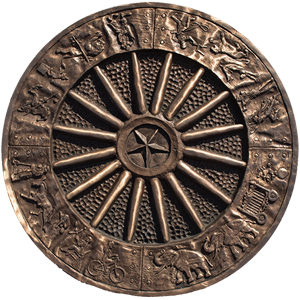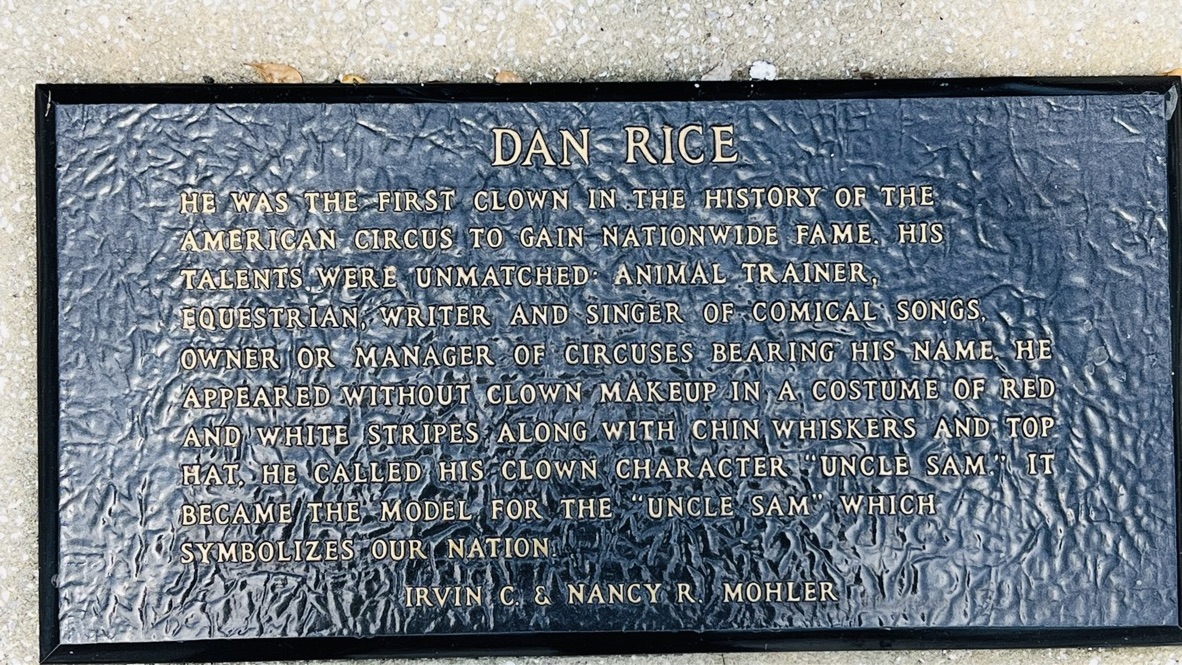[sp_wpcarousel id=”2749″
Dan Rice Ring of Fame biography
David Carlyon
May 1, 2023
Dan Rice (1823-1900) was the greatest clown in nineteenth-century America. But to appreciate his greatness means recognizing that “circus clown” was very different than today’s child-friendly meaning. Rice’s comedy enthralled adults, he was also the century’s most famous circus performer, and a renowned public figure beyond the ring. Americans, circus fans or not, knew Dan Rice.
He began his rise in the 1840s, when circus rose too as a national institution, with boisterous adult fare featuring sex, violence, and politics—and rowdy talking clowns. Rice led the way with comic genius and a lightning quick wit, which Mark Twain later memorialized in the circus episode in the great American novel Huckleberry Finn. Rice added to the sexual titillation of skimpy costumes by telling risqué jokes. The traveling circus experience included daily fights with local toughs, and Rice pitched in so heartily that his fame included his fighting; a plausible story says that “Hey Rube,” the circus rallying cry for a fight, began with Rice. As for politics, he resembled today’s standup comedians as he expanded his jokes into “hits on the times,” comments on current events.
Beyond his great clowning, he also became America’s most renowned circus performer with his stair-walking blind horse Excelsior, the first trained rhinoceros since ancient Rome, and a tightrope-walking elephant. (Though publicity pictured the elephant on a single rope, it was more likely two ropes.) In addition, he was famous a circus owner. Not for business prowess: he occasionally went bankrupt (and his first wife divorced him to marry their show’s treasurer). But his “Dan Rice’s Great Show” was so well known that other companies adopted the title “Great Show,” and stories of circuses used it too. His title had a long lasting—but rarely noticed—influence. After Rice’s publicity agent (and cousin) went to work for the W. C. Coup, Dan Castello, and P. T. Barnum outfit, they varied Rice’s Great Show title with their new slogan, “The Greatest Show on Earth.”
Famous circus clown, famous performer, famous owner, Dan Rice became a famous public figure by pushing beyond the ring. The standard part of a circus clown’s job at the time was teasing and challenging the ringmaster. Rice expanded that practice by challenging well-known people outside performance. When he was arrested for “criminal conversation,” he didn’t deny or shy from the scandal, he rolled in triumph by making the arresting sheriff the butt of jokes. Rice competed for crowds in New Orleans against Barnum and Jenny Lind by teasing Barnum, and a Crescent City newspaper said Rice won that showdown. Observers discussing the controversy over the Astor Place Riots of 1849—the nation’s worst theater violence ever—praised him as the “reading, not acting edition of the clown.” After the editor Horace Greeley employed his New York Tribune to criticize Rice, the talking clown outdueled him, his sword of verbal jabs mightier than Greeley’s pen.
Then Rice ran for office. Histories sometimes treat his campaigns as publicity stunts or jokes but Rice ran in earnest, as a Peace Democrat. He was on the ballot for the Pennsylvania Senate in 1864, and ran ahead of the ticket. Two years later he was the leading candidate going into the Democratic convention to represent northwestern Pennsylvania in Congress but withdrew when party leaders declined to let him run a non-partisan campaign. He was not pals with Abe Lincoln, a common fiction, but he did oppose Lincoln Republicans. Then in late 1867, he was one of the first national candidates considered for president. Though he withdrew in 1868—common in presidential campaigns—papers across the country discussed his potential and some endorsed him.
The Lincoln tall tale reflects one modern problem with Rice’s fame. He had such a major impact on American life—friends with important people, feuding with others, linked to the day’s issues—that fictions, legends, and lies got attached to him like barnacles. Online sources add to the problem: once a fiction gets repeated, it seems to be fact. Rice probably met Zachary Taylor, who attended his show, but he did NOT campaign for Taylor, and he did NOT use the political phrase “get on the bandwagon” (which didn’t appear till after the Civil War). He was not named for an Irish clown, he did not travel with a circus as a child, and he did not create the combination of animals, acrobats, and clowns. And contrary to a mistake made by theater historians, Dan Rice was not T. D. Rice, the blackface song and dance man. (Dan, probably born McLaren, likely did copy T. D.’s last name.) The 1930s “Dan Rice Circus” had no connection to him but does indicate that his renown endured long after his career flourished.
Another story, of Rice as model of Uncle Sam, seems far-fetched but is likely. The cartoonist Thomas Nast, who drew the Uncle Sam icon as we know it now, was a resolute Republican who would never have consciously used the determined Democrat Dan Rice as a model. However, Rice was always on American minds, and consciously or not, Nast combined elements of Rice’s persona: the clown’s standard stripes and stars that he sometimes wore, his other costume of tailcoat and top hat, plus his nationally known goatee. Add Rice’s stature as a national figure and you get the very image Nast drew.
Dan Rice was a colossus of American roads and rivers, both a major circus figure and a symbol of the United States.
Sources:
David Carlyon, Dan Rice: The Most Famous Man You’ve Never Heard Of (New York: Public Affairs, 2001).
Index for “Dan Rice,” Stuart Thayer, Annals of the American Circus: 1793-1860 (Seattle WA: Dauven and Thayer, 2000), assistance by William L. Slout.
Note: A half dozen earlier Rice biographies are interesting but unreliable, each one a stew of accurate evidence, mistaken history, and fictions.


